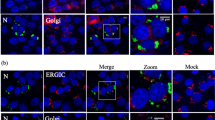Abstract
Viruses (e.g. Human immunodeficiency virus, Human simplex virus and Prototype foamy virus) are obligate intracellular parasites and therefore depend on the cellular machinery for cellular trafficking. Bovine foamy virus (BFV) is a member of the Spumaretrovirinae subfamily of Retroviruses, however, details of its cellular trafficking remain unknown. In this study, we cloned the BFV gag gene into prokaryotic expression vector pET28a and purified the denaturalized Gag protein. The protein was used to immunize BALB/c mouse to produce antiserum, which could specifically recognize the BFV Gag protein in BFV-infected cells through western blot assay. Additionally, these results demonstrated that both the optimal and suboptimal cleavage of Gag protein occur in BFV-infected cells. Subsequently, the Gag antiserum was used to investigate subcellular localization of BFV. In immunofluorescence microscopy assays, colocalization microtubules (MTs) and assembling viral particles were clearly observed, which implied that BFV may transport along cellular MTs in host cells. Furthermore, MTs-depolymerizing assay indicated MTs were required for the efficient replication of BFV. In conclusion, our study suggests that BFV has evolved the mechanism to hijack the cellular cytoskeleton for its replication.
Similar content being viewed by others
References
Broussard S R, Comuzzie A G, Leighton K L, et al. 1997. Characterization of new simian foamy viruses from African nonhuman primates. Virology, 237:349–359.
Dohner K, Nagel C H, Sodeik B. 2005. Viral stop-and-go along microtubules: taking a ride with dynein and kinesins. Trends Microbiol, 13:320–327.
Eastman S W, Linial M L. 2001. Identification of a conserved residue of foamy virus Gag required for intracellular capsid assembly. J Virol, 75:6857–6864.
Hatama S, Otake K, Omoto S, et al. 2001. Isolation and sequencing of infectious clones of feline foamy virus and a human/feline foamy virus Env chimera. J Gen Virol, 82:2999–3004.
Herchenroder O, Renne R, Loncar D, et al. 1994. Isolation, cloning, and sequencing of simian foamy viruses from chimpanzees (SFVcpz): high homology to human foamy virus (HFV). Virology, 201:187–199.
Hirokawa N, Takemura R. 2005. Molecular motors and mechanisms of directional transport in neurons. Nat Rev Neurosci, 6:201–214.
Kodama A, Lechler T, Fuchs E. 2004. Coordinating cytoskeletal tracks to polarize cellular movements. J Cell Biol, 167:203–207.
Linial M L, Eastman S W. 2003. Particle assembly and genome packaging. Curr Top Microbiol Immunol, 277:89–110.
Materniak M, Bicka L, Kuzmak J. 2006. Isolation and partial characterization of bovine foamy virus from Polish cattle. Pol J Vet Sci, 9:207–211.
Murray S M, Linial M L. 2006. Foamy virus infection in primates. J Med Primatol, 35:225–235.
Nogales E. 2000. Structural insights into microtubule function. Annu Rev Biochem, 69:277–302.
Petit C, Giron M L, Tobaly-Tapiero J, et al. 2003. Targeting of incoming retroviral Gag to the centrosome involves a direct interaction with the dynein light chain 8. J Cell Sci, 116:3433–3442.
Pfrepper K I, Lochelt M, Rackwitz H R, et al. 1999. Molecular characterization of proteolytic processing of the Gag proteins of human spumavirus. J Virol, 73:7907–7911.
Pfrepper K I, Rackwitz H R, Schnolzer M, et al. 1998. Molecular characterization of proteolytic processing of the Pol proteins of human foamy virus reveals novel features of the viral protease. J Virol, 72:7648–7652.
Schliephake A W, Rethwilm A. 1994. Nuclear localization of foamy virus Gag precursor protein. J Virol, 68:4946–4954.
Schroer T A. 2004. Dynactin. Annu Rev Cell Dev Biol, 20:759–779.
Sodeik B. 2000. Mechanisms of viral transport in the cytoplasm. Trends Microbiol, 8:465–472.
Tobaly-Tapiero J, Bittoun P, Giron M L, et al. 2001. Human foamy virus capsid formation requires an interaction domain in the N terminus of Gag. J Virol, 75:4367–4375.
Tobaly-Tapiero J, Bittoun P, Neves M, et al. 2000. Isolation and characterization of an equine foamy virus. J Virol, 74:4064–4073.
Vallee R B, Williams J C, Varma D, et al. 2004. Dynein: An ancient motor protein involved in multiple modes of transport. J Neurobiol, 58:189–200.
Yu S F, Baldwin D N, Gwynn S R, et al. 1996. Human foamy virus replication: a pathway distinct from that of retroviruses and hepadnaviruses. Science, 271:1579–1582.
Yu S F, Edelmann K, Strong R K, et al. 1996. The carboxyl terminus of the human foamy virus Gag protein contains separable nucleic acid binding and nuclear transport domains. J Virol, 70:8255–8262.
Author information
Authors and Affiliations
Corresponding author
Additional information
Foundation items: The Key Project of the Ministry of Education of China (108028); National Natural Science Foundation of China (3090068); Grant from State Key Laboratory for Infectious Diseases Prevention and Control, SKL (2008SKLID310).
Rights and permissions
About this article
Cite this article
Wang, J., Guo, Hy., Jia, R. et al. Preparation of BFV Gag antiserum and preliminary study on cellular distribution of BFV. Virol. Sin. 25, 115–122 (2010). https://doi.org/10.1007/s12250-010-3110-8
Received:
Accepted:
Published:
Issue Date:
DOI: https://doi.org/10.1007/s12250-010-3110-8




